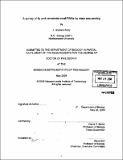| dc.contributor.advisor | David P. Bartel. | en_US |
| dc.contributor.author | Ruby, J. Graham (James Graham) | en_US |
| dc.contributor.other | Massachusetts Institute of Technology. Dept. of Biology. | en_US |
| dc.date.accessioned | 2008-11-07T19:18:46Z | |
| dc.date.available | 2008-11-07T19:18:46Z | |
| dc.date.copyright | 2008 | en_US |
| dc.date.issued | 2008 | en_US |
| dc.identifier.uri | http://hdl.handle.net/1721.1/43230 | |
| dc.description | Thesis (Ph. D.)--Massachusetts Institute of Technology, Dept. of Biology, 2008. | en_US |
| dc.description | "Suppl. materials for chapters 2 + 4"--handwritten on CDROM. Vita. | en_US |
| dc.description | Includes bibliographical references. | en_US |
| dc.description.abstract | Small RNAs of -22 nt length play a variety of roles in the biology of animals by repressing the translation or stimulating the degradation of complementary messenger RNAs. Depending on the structure of their precursors, they can be categorized as either microRNAs (miRNAs) or small interfering RNAs (siRNAs). In animals, miRNAs derive from characteristic hairpins in primary transcripts through two sequential RNase III-mediated cleavages; Drosha cleaves near the base of the stem to liberate a pre-miRNA hairpin, then Dicer cleaves near the loop to generate a miRNA:miRNA* duplex. Large-scale sequencing of cDNAs derived from endogenously expressed small RNAs is used here to examine the small RNAs of the nematode Caenorhabditis elegans and the fly Drosophila melanogaster, revealing a number of previously unidentified miRNA genes from each organism. These data also revealed a novel miRNA biogenesis pathway, the mirtron pathway, in which debranched introns mimic the structural features of pre-miRNAs to enter the miRNA-processing pathway without Drosha-mediated cleavage. Mirtrons were identified in both D. melanogaster and C. elegans, some of which exhibit patterns of sequence conservation suggesting important regulatory functions. Sequencing was performed across a time-course of D. melanogaster development, permitting refinement of preexisting miRNA annotations and providing insights into miRNA biogenesis and expression. Conserved miRNAs were typically expressed more broadly and robustly than non conserved miRNAs, and miRNAs with more restricted expression tended to have fewer predicted targets. Insights were also provided into miRNA gene evolution. | en_US |
| dc.description.abstract | (cont.) Finally, two possible sources of endogenous siRNAs were revealed: antisense transcription and endogenous hpRNAs. Besides miRNAs, sequencing from C. elegans revealed thousands of endogenous siRNAs generated by RNA-directed RNA polymerases acting preferentially on spermatogenesis- and transposon-associated transcripts. A third class of nematode small RNAs, called 21U-RNAs, was also discovered. 21U-RNAs are precisely 21 nucleotides long and begin with a uridine but are diverse in their remaining 20 nucleotides. 21U-RNAs originate from >5700 genomic loci dispersed in two broad regions of chromosome IV. These loci share an upstream motif that enables accurate prediction of additional 21U-RNAs. The motif is conserved in other nematodes, presumably because of its importance for producing these diverse, autonomously expressed, small RNAs. | en_US |
| dc.description.statementofresponsibility | by J. Graham Ruby. | en_US |
| dc.format.extent | 233 p. | en_US |
| dc.language.iso | eng | en_US |
| dc.publisher | Massachusetts Institute of Technology | en_US |
| dc.relation.requires | CDROM contains files in .fa, .html and .xls formats. | en_US |
| dc.rights | M.I.T. theses are protected by
copyright. They may be viewed from this source for any purpose, but
reproduction or distribution in any format is prohibited without written
permission. See provided URL for inquiries about permission. | en_US |
| dc.rights.uri | http://dspace.mit.edu/handle/1721.1/7582 | en_US |
| dc.subject | Biology. | en_US |
| dc.title | A survey of fly and nematode small RNAs by deep sequencing | en_US |
| dc.type | Thesis | en_US |
| dc.description.degree | Ph.D. | en_US |
| dc.contributor.department | Massachusetts Institute of Technology. Department of Biology | |
| dc.identifier.oclc | 259805533 | en_US |
